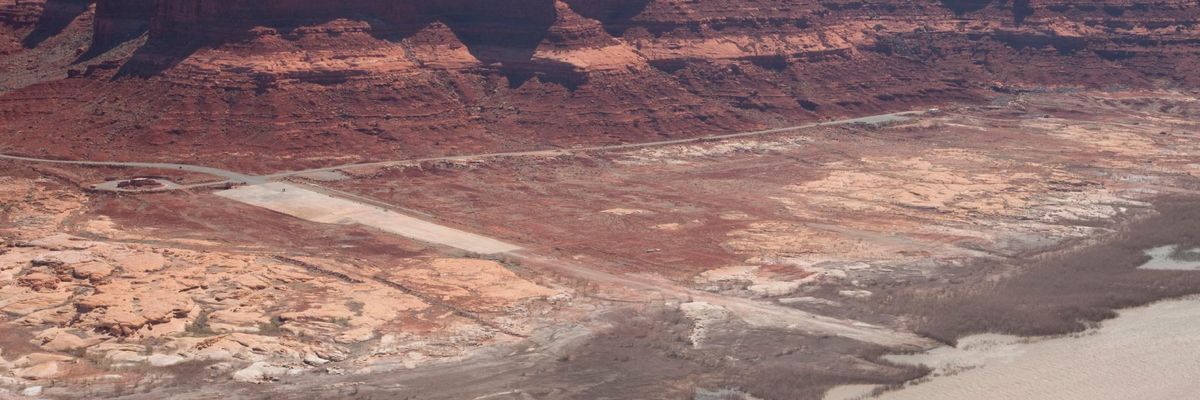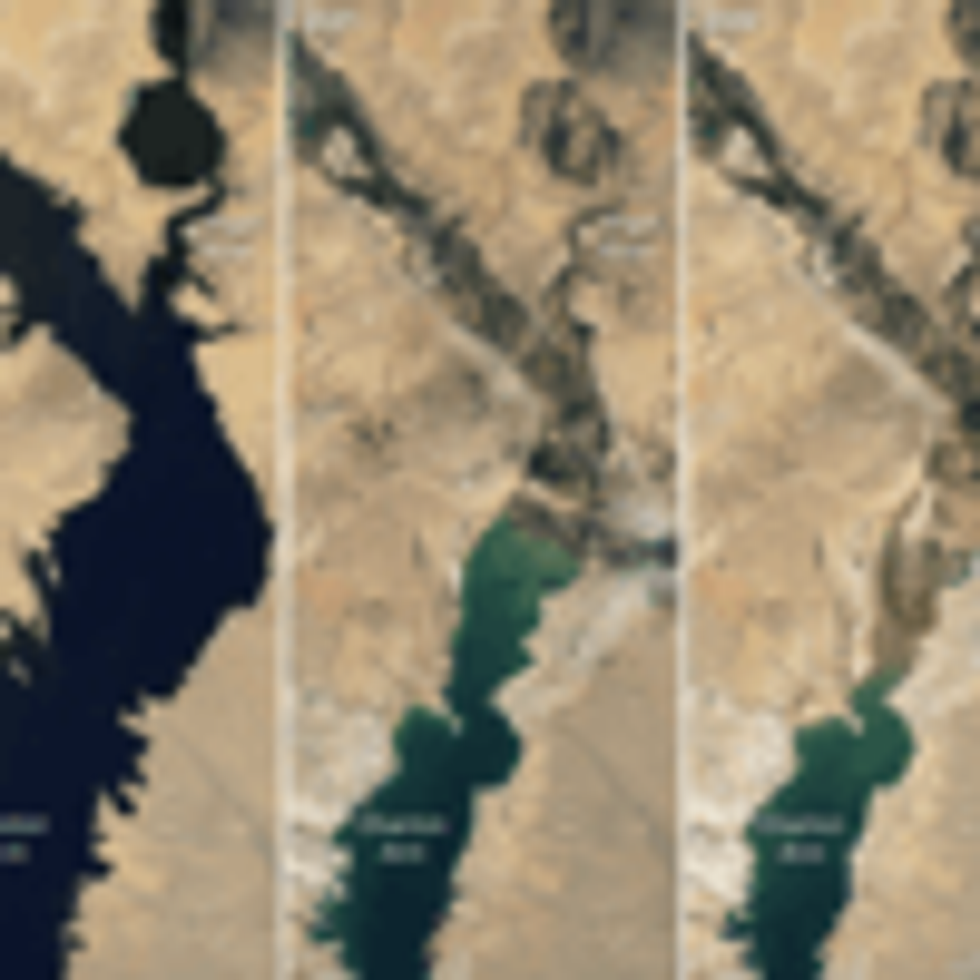

SUBSCRIBE TO OUR FREE NEWSLETTER
Daily news & progressive opinion—funded by the people, not the corporations—delivered straight to your inbox.
5
#000000
#FFFFFF
To donate by check, phone, or other method, see our More Ways to Give page.


Daily news & progressive opinion—funded by the people, not the corporations—delivered straight to your inbox.

A boat launch lies stranded due to low water levels brought on by drought at Lake Powell, Utah on May 2, 2022. (Photo: Marli Miller/UCG/Universal Images Group via Getty Images)
Addressing the root causes of the climate crisis is essential to solving the worsening problem of water shortages in the Colorado River Basin, said a top environmental expert at the United Nations on Tuesday, emphasizing that the aridification of the region is part of a larger global trend.
The two largest reservoirs in the U.S., Lake Powell and Lake Mead, are part of the Colorado River watershed, and are both on the precipice of reaching dangerous "dead pool" status, according to the United Nations Environment Program (UNEP), with water levels dropping so low that water no longer flows downstream from the reservoirs.
"Overconsumption and the climate crisis could lead to water levels so low that downstream flows to hydroelectric plants would stop," tweeted UNEP, which would jeopardize access to electricity for millions of people in western states.
\u201cTwo of the largest reservoirs in the United States are in danger of reaching \u2018dead pool status.\u2019\n\nOverconsumption & the #ClimateCrisis could lead to water levels\ud83d\udca7so low that downstream flows to hydroelectric plants would stop \u2935\ufe0f\nhttps://t.co/ToIZw2fIPM\u201d— UN Environment Programme (@UN Environment Programme) 1659438001
Maria Morgardo, UNEP's ecosystems officer for North America, noted that officials are expected to advise people across the region to cut water consumption, but stressed that the crisis is beyond the point of simply mitigating the effects.
"While regulating and managing water supply and demand are essential in both the short and long term, climate change is at the heart of this issue."
"While regulating and managing water supply and demand are essential in both the short and long term, climate change is at the heart of this issue," Morgardo said in a statement. "In the long term we need to address the root causes of climate change as well as water demands."
As Common Dreams reported in July, Lake Mead is currently at just 27% capacity. By the end of the year, scientists expect both human-made reservoirs to reach 25% capacity.
The Colorado River Basin provides water for more than 40 million people across California, Colorado, New Mexico, Utah, Wyoming, Arizona, and Nevada as well as northern Mexico. It also provides irrigation for agriculture in the region.
Climate experts say the human-caused climate crisis, driven by fossil fuel extraction, increases the risk of drought conditions like those seen in the West over the past two decades by pushing temperatures higher, reducing snowfall, and shifting the regions where rain storms fall.
Related Content

The dry conditions in the West have become so prolonged, said UNEP ecosystems expert Lis Mullin Bernhardt, that "drought" is no longer the appropriate word to describe them.
"We refer to it as 'aridification'--a new very dry normal," Bernhardt said in a statement.
People across the American West are among about 2.3 billion people around the world who face water stress annually, as up to 40% of the world's land has become degraded--a condition that can be driven by drought.
"Drought and desertification are quickly becoming the new normal everywhere--from the U.S. to Europe and Africa," said UNEP.
In the U.S., the agency said, "drying American reservoirs underscore the need for urgent climate action."
Dear Common Dreams reader, The U.S. is on a fast track to authoritarianism like nothing I've ever seen. Meanwhile, corporate news outlets are utterly capitulating to Trump, twisting their coverage to avoid drawing his ire while lining up to stuff cash in his pockets. That's why I believe that Common Dreams is doing the best and most consequential reporting that we've ever done. Our small but mighty team is a progressive reporting powerhouse, covering the news every day that the corporate media never will. Our mission has always been simple: To inform. To inspire. And to ignite change for the common good. Now here's the key piece that I want all our readers to understand: None of this would be possible without your financial support. That's not just some fundraising cliche. It's the absolute and literal truth. We don't accept corporate advertising and never will. We don't have a paywall because we don't think people should be blocked from critical news based on their ability to pay. Everything we do is funded by the donations of readers like you. Will you donate now to help power the nonprofit, independent reporting of Common Dreams? Thank you for being a vital member of our community. Together, we can keep independent journalism alive when it’s needed most. - Craig Brown, Co-founder |
Addressing the root causes of the climate crisis is essential to solving the worsening problem of water shortages in the Colorado River Basin, said a top environmental expert at the United Nations on Tuesday, emphasizing that the aridification of the region is part of a larger global trend.
The two largest reservoirs in the U.S., Lake Powell and Lake Mead, are part of the Colorado River watershed, and are both on the precipice of reaching dangerous "dead pool" status, according to the United Nations Environment Program (UNEP), with water levels dropping so low that water no longer flows downstream from the reservoirs.
"Overconsumption and the climate crisis could lead to water levels so low that downstream flows to hydroelectric plants would stop," tweeted UNEP, which would jeopardize access to electricity for millions of people in western states.
\u201cTwo of the largest reservoirs in the United States are in danger of reaching \u2018dead pool status.\u2019\n\nOverconsumption & the #ClimateCrisis could lead to water levels\ud83d\udca7so low that downstream flows to hydroelectric plants would stop \u2935\ufe0f\nhttps://t.co/ToIZw2fIPM\u201d— UN Environment Programme (@UN Environment Programme) 1659438001
Maria Morgardo, UNEP's ecosystems officer for North America, noted that officials are expected to advise people across the region to cut water consumption, but stressed that the crisis is beyond the point of simply mitigating the effects.
"While regulating and managing water supply and demand are essential in both the short and long term, climate change is at the heart of this issue."
"While regulating and managing water supply and demand are essential in both the short and long term, climate change is at the heart of this issue," Morgardo said in a statement. "In the long term we need to address the root causes of climate change as well as water demands."
As Common Dreams reported in July, Lake Mead is currently at just 27% capacity. By the end of the year, scientists expect both human-made reservoirs to reach 25% capacity.
The Colorado River Basin provides water for more than 40 million people across California, Colorado, New Mexico, Utah, Wyoming, Arizona, and Nevada as well as northern Mexico. It also provides irrigation for agriculture in the region.
Climate experts say the human-caused climate crisis, driven by fossil fuel extraction, increases the risk of drought conditions like those seen in the West over the past two decades by pushing temperatures higher, reducing snowfall, and shifting the regions where rain storms fall.
Related Content

The dry conditions in the West have become so prolonged, said UNEP ecosystems expert Lis Mullin Bernhardt, that "drought" is no longer the appropriate word to describe them.
"We refer to it as 'aridification'--a new very dry normal," Bernhardt said in a statement.
People across the American West are among about 2.3 billion people around the world who face water stress annually, as up to 40% of the world's land has become degraded--a condition that can be driven by drought.
"Drought and desertification are quickly becoming the new normal everywhere--from the U.S. to Europe and Africa," said UNEP.
In the U.S., the agency said, "drying American reservoirs underscore the need for urgent climate action."
Addressing the root causes of the climate crisis is essential to solving the worsening problem of water shortages in the Colorado River Basin, said a top environmental expert at the United Nations on Tuesday, emphasizing that the aridification of the region is part of a larger global trend.
The two largest reservoirs in the U.S., Lake Powell and Lake Mead, are part of the Colorado River watershed, and are both on the precipice of reaching dangerous "dead pool" status, according to the United Nations Environment Program (UNEP), with water levels dropping so low that water no longer flows downstream from the reservoirs.
"Overconsumption and the climate crisis could lead to water levels so low that downstream flows to hydroelectric plants would stop," tweeted UNEP, which would jeopardize access to electricity for millions of people in western states.
\u201cTwo of the largest reservoirs in the United States are in danger of reaching \u2018dead pool status.\u2019\n\nOverconsumption & the #ClimateCrisis could lead to water levels\ud83d\udca7so low that downstream flows to hydroelectric plants would stop \u2935\ufe0f\nhttps://t.co/ToIZw2fIPM\u201d— UN Environment Programme (@UN Environment Programme) 1659438001
Maria Morgardo, UNEP's ecosystems officer for North America, noted that officials are expected to advise people across the region to cut water consumption, but stressed that the crisis is beyond the point of simply mitigating the effects.
"While regulating and managing water supply and demand are essential in both the short and long term, climate change is at the heart of this issue."
"While regulating and managing water supply and demand are essential in both the short and long term, climate change is at the heart of this issue," Morgardo said in a statement. "In the long term we need to address the root causes of climate change as well as water demands."
As Common Dreams reported in July, Lake Mead is currently at just 27% capacity. By the end of the year, scientists expect both human-made reservoirs to reach 25% capacity.
The Colorado River Basin provides water for more than 40 million people across California, Colorado, New Mexico, Utah, Wyoming, Arizona, and Nevada as well as northern Mexico. It also provides irrigation for agriculture in the region.
Climate experts say the human-caused climate crisis, driven by fossil fuel extraction, increases the risk of drought conditions like those seen in the West over the past two decades by pushing temperatures higher, reducing snowfall, and shifting the regions where rain storms fall.
Related Content

The dry conditions in the West have become so prolonged, said UNEP ecosystems expert Lis Mullin Bernhardt, that "drought" is no longer the appropriate word to describe them.
"We refer to it as 'aridification'--a new very dry normal," Bernhardt said in a statement.
People across the American West are among about 2.3 billion people around the world who face water stress annually, as up to 40% of the world's land has become degraded--a condition that can be driven by drought.
"Drought and desertification are quickly becoming the new normal everywhere--from the U.S. to Europe and Africa," said UNEP.
In the U.S., the agency said, "drying American reservoirs underscore the need for urgent climate action."